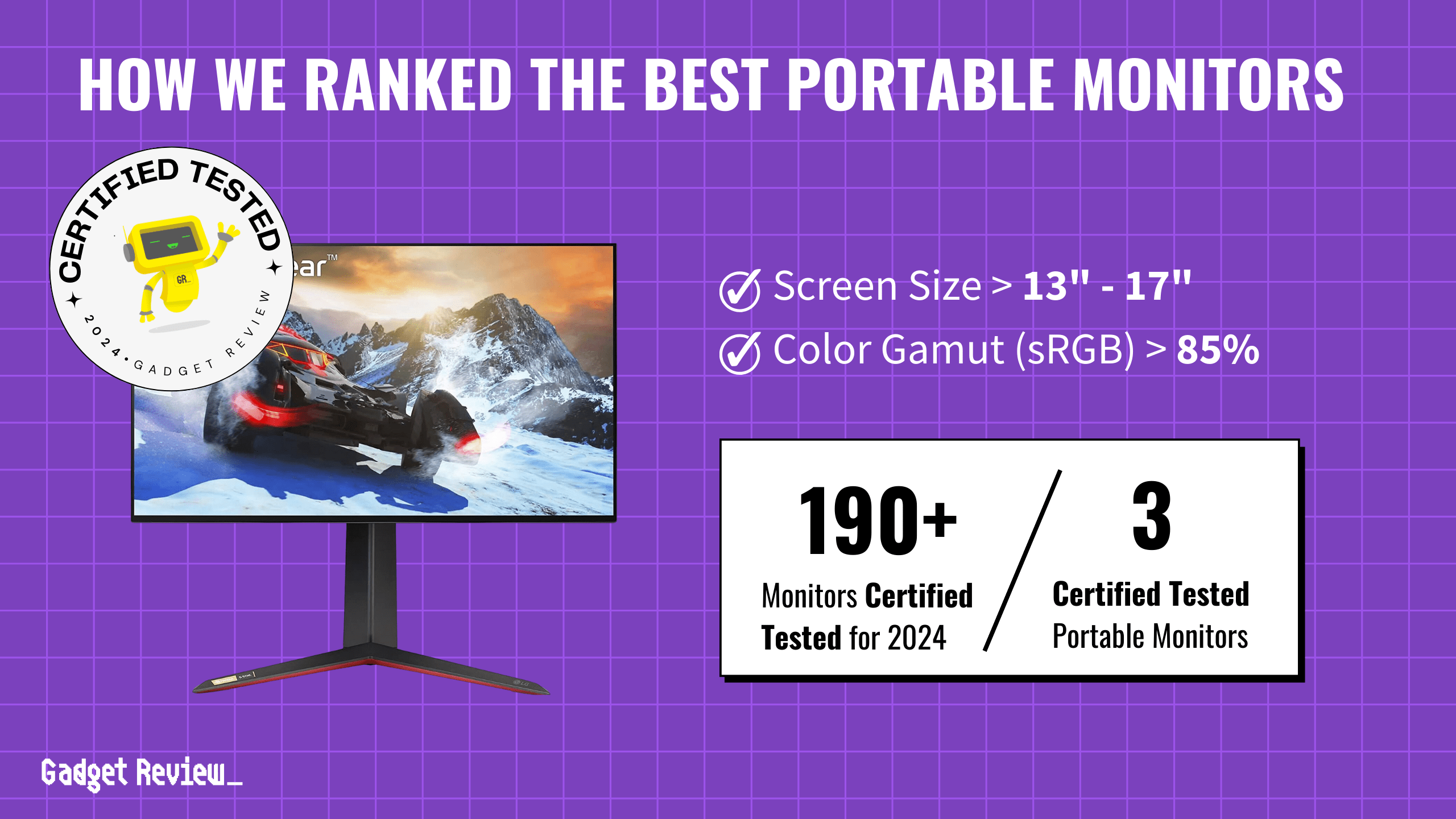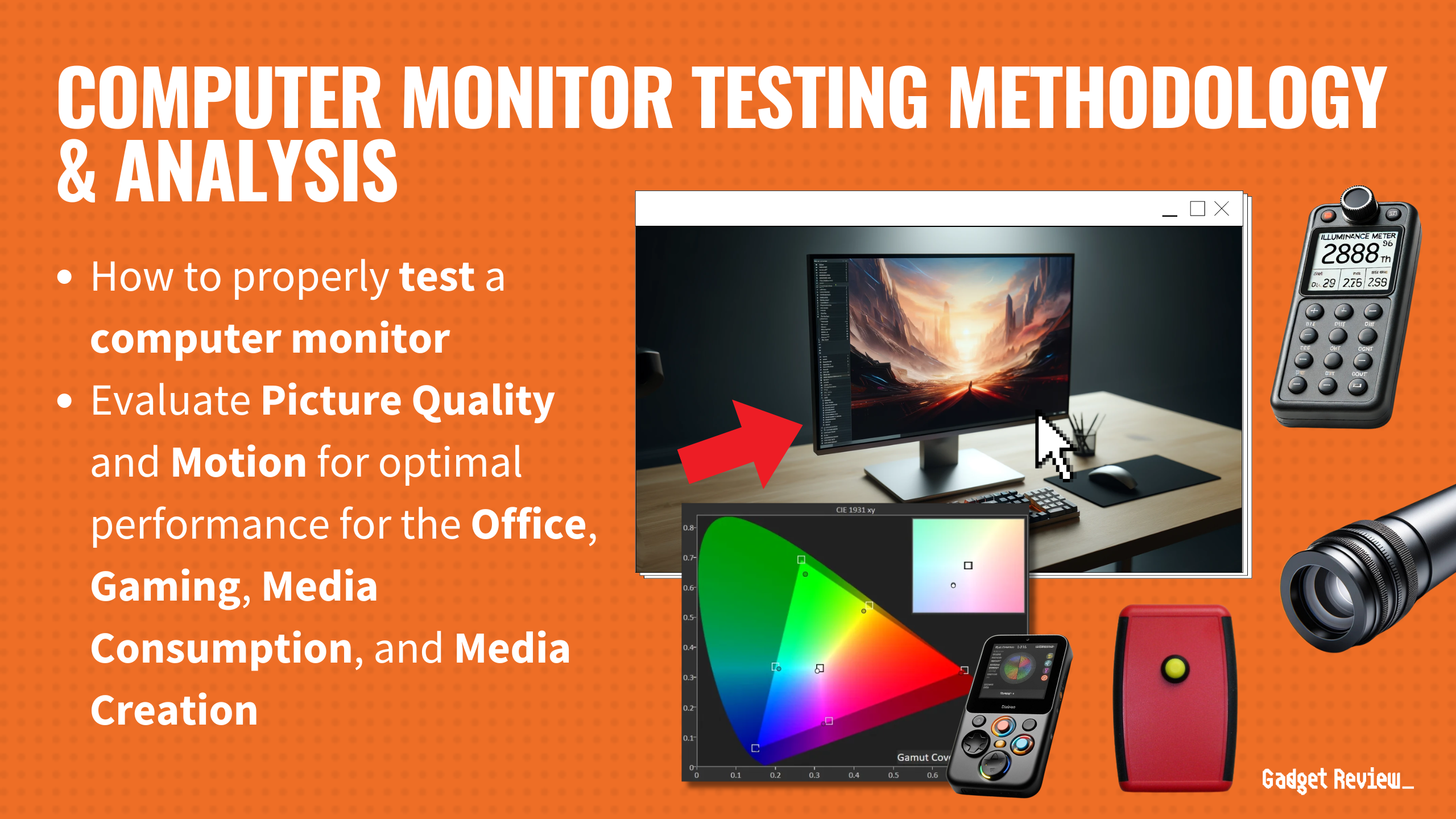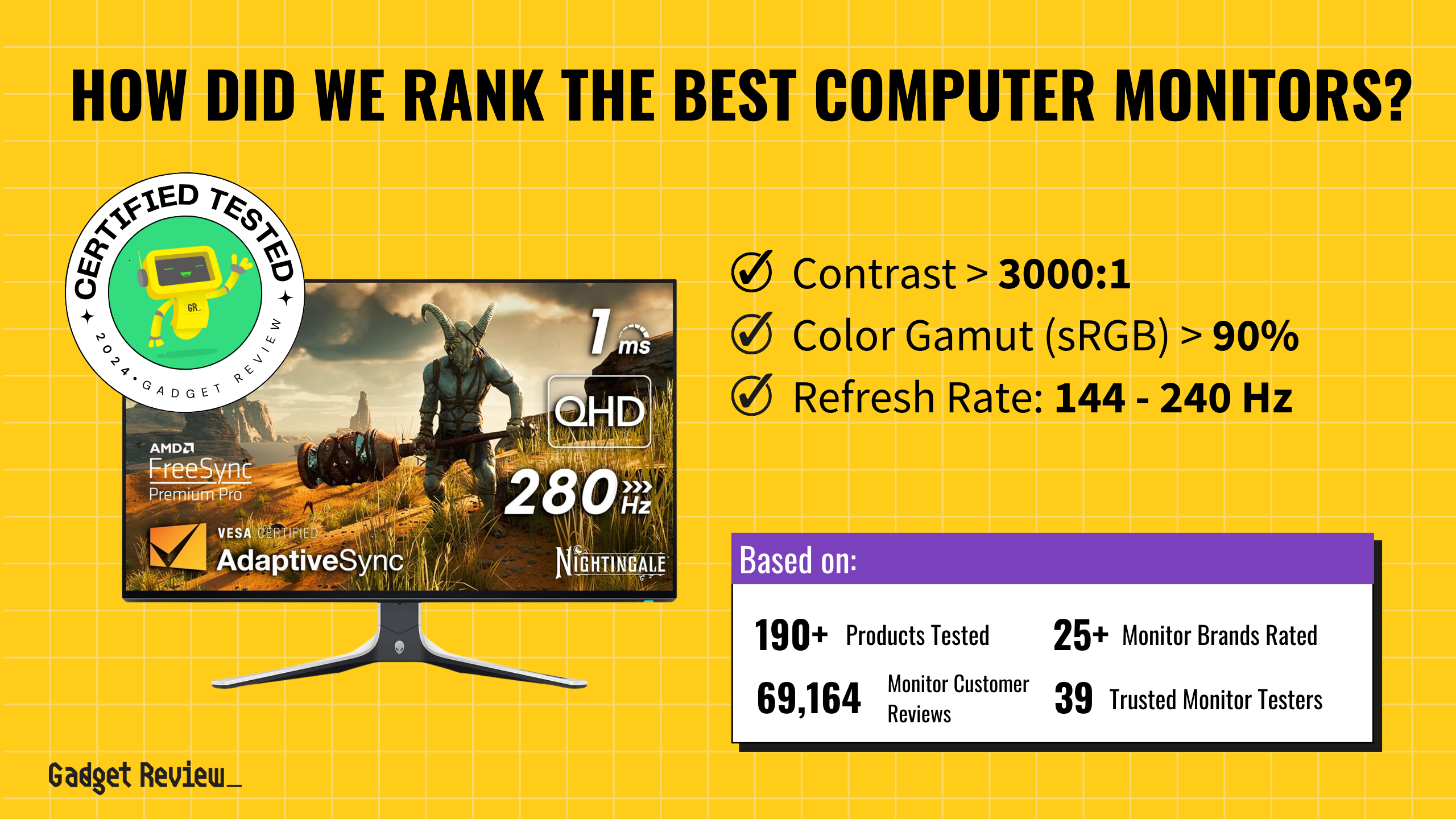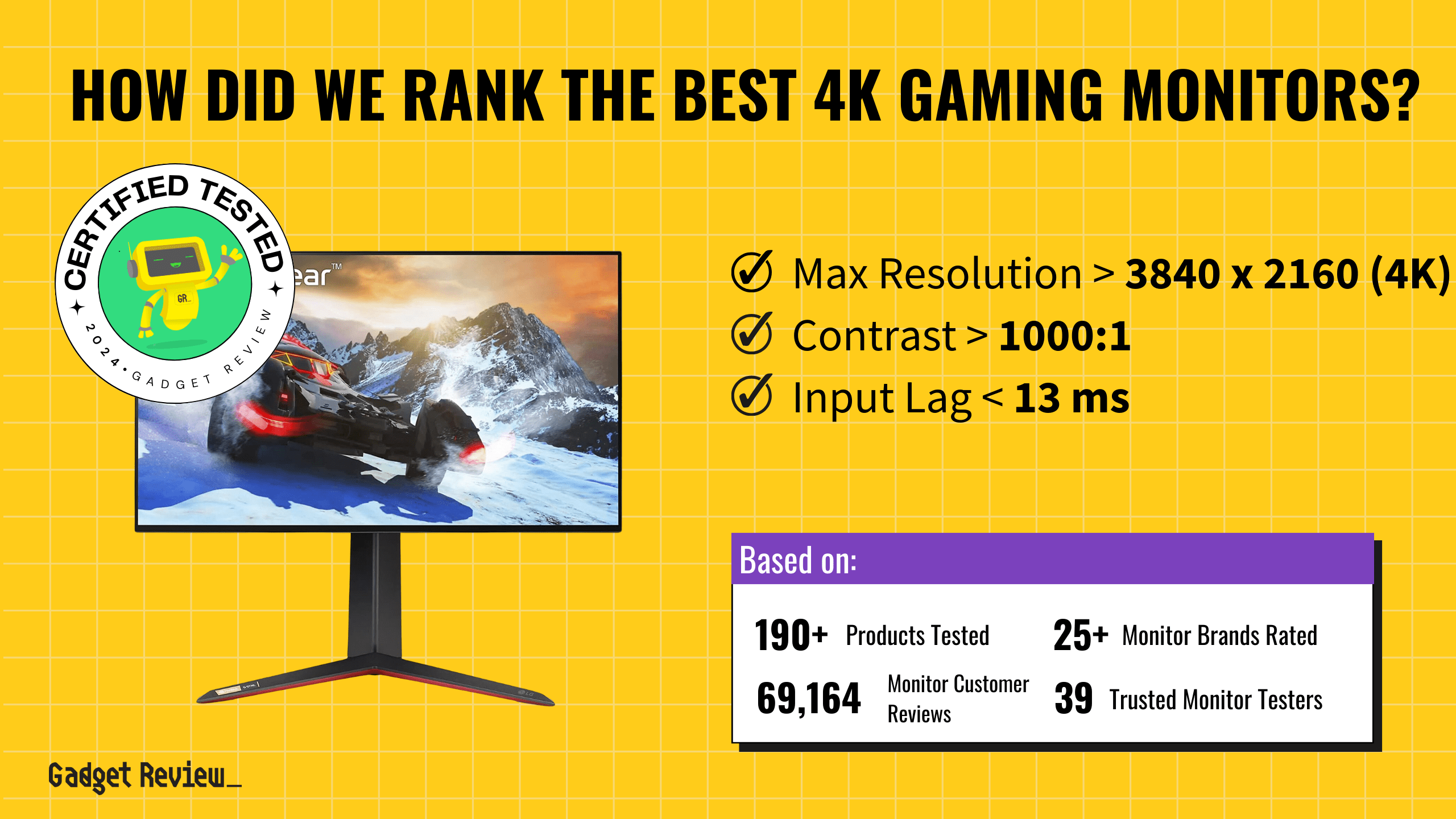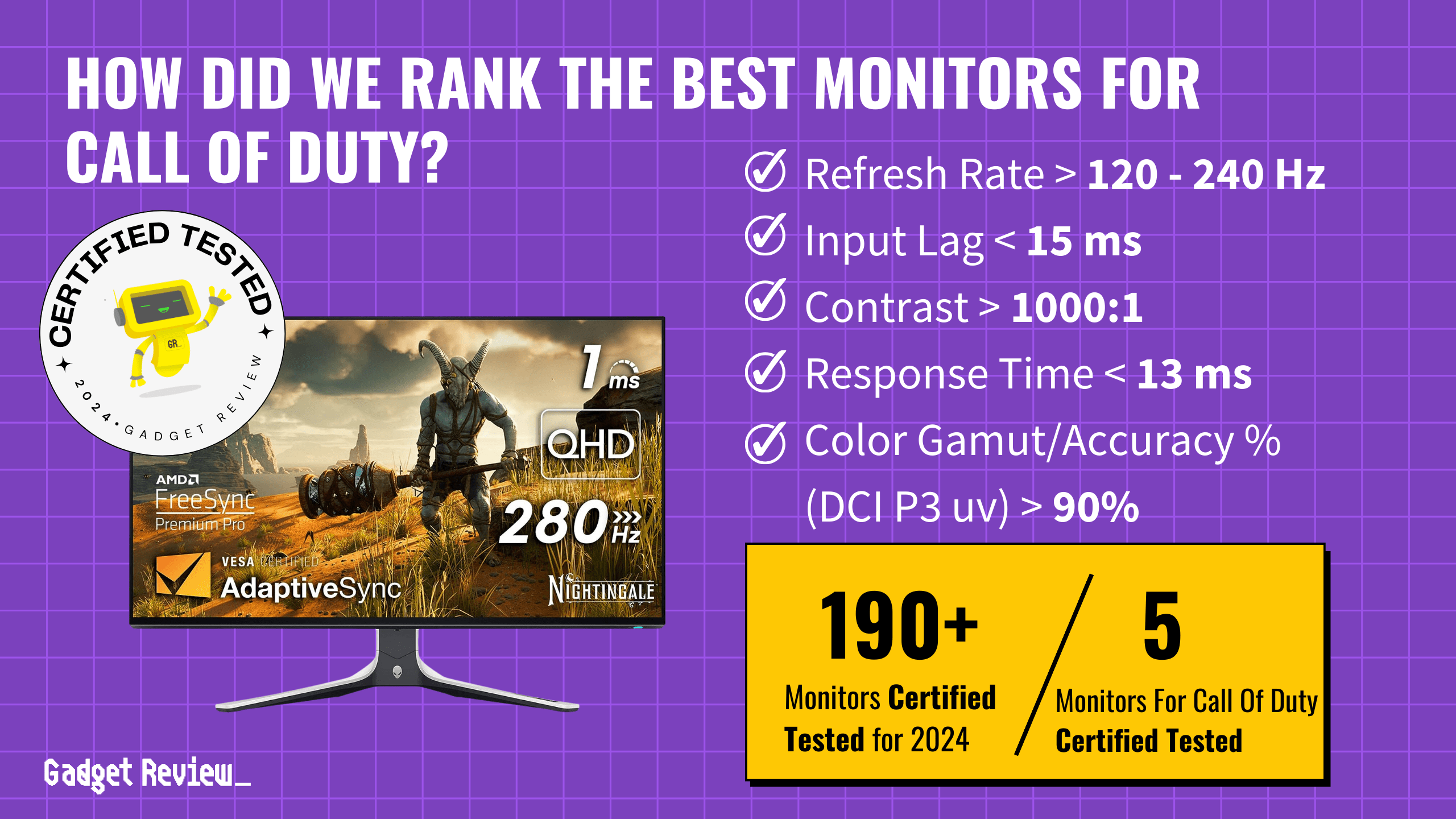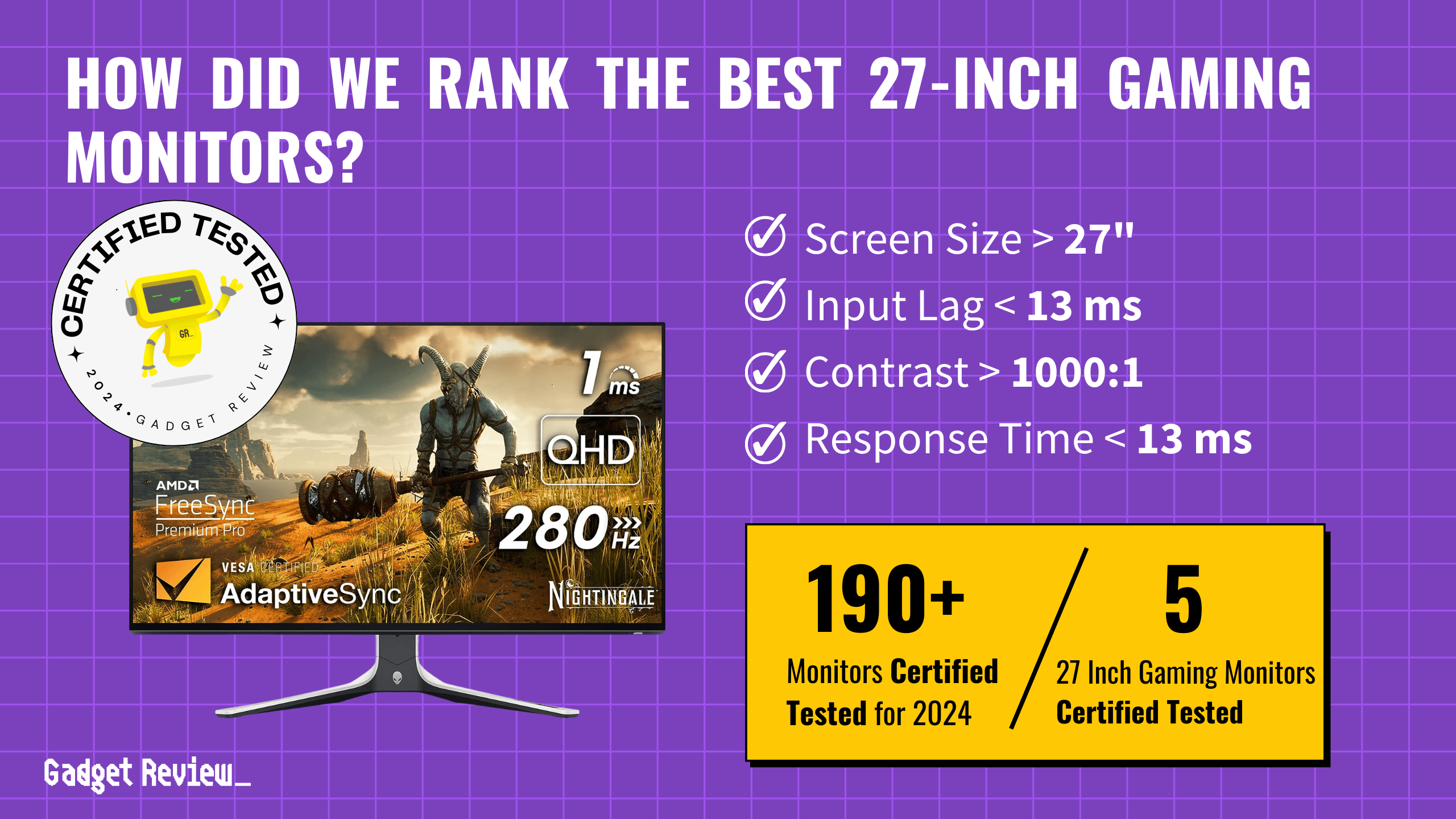When choosing the best portable monitor, prioritize image quality and portability. These monitors, under 17 inches, should offer excellent color gamut coverage and a decent contrast ratio to ensure vibrant, dynamic images. Features like blue-light filters, flicker-free displays, and adjustable stands enhance comfort during extended use.
Out of over 196 monitors analyzed and 320,359 reviews, we certified three top models. A staggering 71% of experts produced unreliable reviews, but our rigorous process filtered them out. Our winners excelled in our tests, proving reliable and high-performing for portable use. While our focus here is on portable models, our research also covers a broader range of choices, featuring the top computer monitors and excellent gaming monitor options.
How Did We Rank the Best Portable Monitors?
To bring you the best portable monitors, Gadget Review analyzed data from over 200 websites, including testing methods and customer reviews. Our experts evaluated reviews and distilled the information into our True Score system. This approach identified 2 required test results and 1 essential specification. By focusing on what matters most to users, we created a buying guide that is both precise and practical, ensuring you make an informed decision.
Our commitment to unbiased reviews is powered by our ‘True Score’ system, targeting low quality and fake reviews. When you shop through our links, you’re backing our mission. Dive deeper to see how.
Minimum Specifications
- Screen size must be 17 inches or less.
Test Criteria
- Color Accuracy: At least 95% of the sRGB color gamut, providing rich and vibrant colors.
- Contrast Ratio: 1000:1 or higher (infinite), offering deep blacks and bright whites for an exceptional viewing experience.
Latest Updates
- 04/30/2024: Republished the list to include the best portable monitors based on our True Score system.
Top Portable Monitors For 2025
Prices accurate at the time of publishing

Best Overall

Runner Up

Best Value

Best Budget

Best Mid-Range

Premium Pick
Asus Proart PA148CTV
Best For Portable
For professionals valuing portability, the Asus Proart PA148CTV is a solid investment despite its premium cost and slightly lower contrast and brightness.
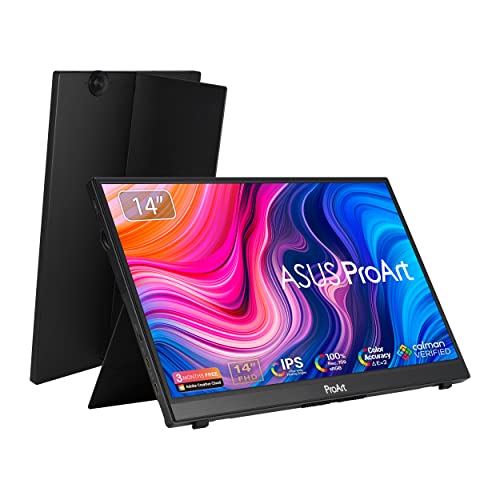
True Score
81803Experts
892kCustomers
Absolutely Fresh
 $319.50
$319.50Snapshot
Reasons to Buy
- Superb text clarity
- Exceptional gray uniformity
- Very low input lag and response time
- Excellent color accuracy out of the box
- Fantastic SDR color volume coverage
Reasons to Avoid
- Limited to only 60 Hz refresh rate
- No presence of wide color gamuts or HDR
- Poor native contrast ratio
- Terrible black levels
- The ergonomics could’ve been better
Specifications
Display Type LCD HDMI Inputs 1 HDR Format n/a Max Resolution 1920 x 1080 (Full HD) 
Panel Type IPS Refresh Rate 60 Hz 
Response Time 5 ms Screen size 14" 
Sync Technology n/a All Specs
Test Results
Brightness (nits) 251 Contrast Ratio (as ratio x:1) 985 Color Gamut/Accuracy % (DCI P3 xy) 70 Color Gamut/Accuracy % (DCI P3 uv) 0 Color Gamut % (sRGB Coverage xy) 97 Color Gamut % (Adobe RGB Coverage xy) 71 All Retailers
- $319.50
- $365.99$399Save $33
- $399.99
- $399.00
Our Verdict
If you’re willing to invest in premium quality, the Asus Proart PA148CTV stands out as a portable monitor offering performance that reflects its higher price. With its compact 14-inch screen size, this monitor is ideal for those on the go. It has a brightness of 251.0 nits, and it guarantees clear and visible displays in various indoor scenarios, from brightly lit office spaces to dimmer home environments, ensuring content is always easy to read.
Although it has the lowest contrast ratio on our list at 985:1, the monitor still delivers vibrant and rich images that bring depth to document viewing and video playback. While its 8.7 ms response time is not as fast as the 5.6 ms of the Asus Rog Strix XG16AHPE, it is sufficiently quick for many applications. Combined with a 60 Hz refresh rate, this monitor offers a smooth viewing experience for most content. Its input lag of 9.1 ms ensures swift reactions to user inputs.
With 97.35% coverage of the sRGB color spectrum, this portable monitor is an excellent choice for activities that demand accurate color reproduction. Although it might not reach the ultimate precision sought by some graphic design or photography professionals, its color accuracy is impressive and perfectly adequate for general web browsing, casual photo editing, and productivity tasks.
Despite its premium cost, the Asus Proart PA148CTV provides a well-rounded feature set, making it a valuable choice for those seeking quality in a portable format. While it may not meet the advanced requirements of hardcore gamers or color perfectionists, it offers a reliable solution for daily use and various content consumption needs, making it a wise investment for those prioritizing portability and quality.

Best Overall

Runner Up

Best Value

Best Budget

Best Mid-Range

Premium Pick
Dell C1422H
Best For Cheap
For on-the-go professionals and students, the Dell C1422H is a top pick for its compactness, quick response, and solid performance at a great price.

True Score
79786Experts
86126Customers
Mixed Reviews
 SAVE $49$298.95$249.99
SAVE $49$298.95$249.99Snapshot
Reasons to Buy
- Bright screen
- Good reflection handling
- Excellent gray uniformity
- Two USB-C ports
- Good SDR color gamut
Reasons to Avoid
- Lacks HDMI interface
- Very slow 28.4 ms response time
- Low 1,275:1 contrast ratio
Specifications
Display Type LCD HDMI Inputs 1 HDR Format Yes Max Resolution 1920 x 1080 (Full HD) 
Panel Type IPS Refresh Rate 60 Hz 
Response Time 28.4 ms Screen size 14" 
Sync Technology n/a All Specs
Test Results
Brightness (nits) 266 Contrast Ratio (as ratio x:1) 1,145 Color Gamut/Accuracy % (DCI P3 xy) 73 Color Gamut/Accuracy % (DCI P3 uv) 0 Color Gamut % (sRGB Coverage xy) 99 Color Gamut % (Adobe RGB Coverage xy) 75 All Retailers
- $249.99$299Save $49
- $279.95
- $379.99$469Save $89
Our Verdict
If you are a professional or student looking for a portable monitor, the Dell C1422H is an excellent choice. With its impressively low input lag of 8.6ms, it ensures quick interactions, making it stand out compared to its peers, such as the Asus Rog Strix XG16AHPE, which lags slightly behind with a response time of 9ms. This makes the Dell monitor a highly responsive choice, particularly for tasks requiring fast feedback.
If crisp and blur-free content matters most to you, the Dell C1422H’s response time of 6.5ms is good for a portable monitor, reducing motion blur during video playback or high-speed activities. And though the standard 60Hz refresh rate might not satisfy serious gamers, it’s more than sufficient for general use and video streaming. The Dell C1422H also covers an impressive 98.90% of the sRGB color gamut, offering superb color accuracy.
The Dell C1422H further enhances its value with a decent contrast ratio of 1145:1, providing a reasonable visual depth level. While it may not be as vivid as higher-end options, it offers a good visual experience for most users with a 14-inch screen. The monitor’s brightness level of 266.1 nits also ensures clear visibility in most indoor environments without causing excessive glare.
The Dell C1422H stands out as an ideal option for professionals and students on the move. It offers a great blend of affordability and performance. Its high color accuracy and decent response time are excellent for a portable monitor. As the most budget-friendly choice on our list, it strikes an optimal balance between cost and features. While it’s suitable for gaming, its portability and professional performance are where it excels.

DON’T SEE WHAT YOU’RE LOOKING FOR?
For Nintendo enthusiasts, selecting the best monitor for Nintendo Switch can significantly enhance your gaming experience with superior image quality and responsiveness ideal for both casual and competitive play. Additionally, our AOC i1601fwux portable USB C monitor review highlights this model’s flexibility and convenience for gamers and professionals on the go, thanks to its sleek design and easy connectivity.
Those in creative and technical fields may prefer the best vertical monitor, which optimizes viewing for long text documents and coding environments. To maintain visual clarity and longevity of these displays, it’s crucial to know how to clean a monitor without streaks, ensuring your screen remains spotless and functional without causing damage.

Best Overall

Runner Up

Best Value

Best Budget

Best Mid-Range

Premium Pick
Asus Rog Strix XG16AHPE
Best For Asus
The Asus Rog Strix XG16AHPE delivers unmatched gaming performance for a portable monitor with a high refresh rate, ideal for smooth, tear-free gameplay.
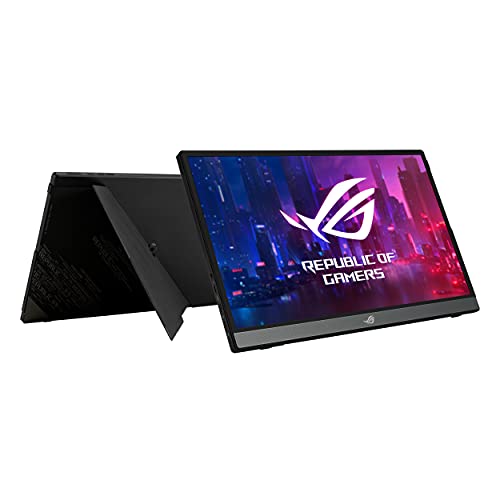
True Score
70713Experts
76204Customers
Mixed Reviews
 $449.99
$449.99Snapshot
Reasons to Buy
- It comes with a built-in high-capacity 7800mAh battery
- Exceptionally low input lag and response time
- Supremely wide viewing angles
- Extremely sturdy built-in fold-out kickstand
- Native 144 Hz display refresh rate
Reasons to Avoid
- It does not have HDMI 2.1
- Limited to only 8-bit color
- No presence of Black Frame Insertion feature
- Limited color gamuts
- Mediocre native contrast ratio and black levels
Specifications
Display Type LCD HDMI Inputs 1 HDR Format n/a Max Resolution 1920 x 1080 (Full HD) 
Panel Type IPS Refresh Rate 144 Hz 
Response Time 3 ms Screen size 15.6" 
Sync Technology G-Sync All Specs
Test Results
Brightness (nits) 295 Contrast Ratio (as ratio x:1) 1,216 Color Gamut/Accuracy % (DCI P3 xy) 73 Color Gamut/Accuracy % (DCI P3 uv) 0 Color Gamut % (Adobe RGB Coverage xy) 74 Color Gamut % (sRGB Coverage xy) 99 All Retailers
- $449.99
Our Verdict
If you’re a gamer seeking a monitor that ensures smooth motion and reduces screen tearing and stuttering during gameplay, the Asus Rog Strix XG16AHPE is the perfect choice. Its standout feature is a 144 Hz refresh rate, coupled with G-Sync technology, making it a top pick for gamers. Moreover, the lowest response time on our list, at 5.6 ms, ensures clearer motion handling compared to the Asus Proart PA148CTV, with its 8.7 ms response time. Although its input lag is slightly higher at 9.0 ms, it maintains responsiveness suitable for various applications, from gaming to professional tasks.
The portable monitor also excels in bright rooms or when dealing with a ton of ambient light thanks to its impressive brightness of 295.0 nits, which outperforms the Dell C1422H’s 266.075 nits. This monitor further impresses with a low reflectivity of 5.2%, making it ideal for brightly lit environments without causing significant glare issues. With its larger screen size of 15.6 inches, the Asus Rog Strix XG16AHPE provides an expansive display for gaming and productivity. It doesn’t disappoint in color accuracy, with a color gamut coverage of 99.3% sRGB, it’s well-suited for tasks that require precise color representation. Its impressive 1216:1 contrast ratio also ensures vibrant colors and sharp details, elevating the visual experience.
Whether you’re a gamer, a content creator, or simply require a large, bright, and accurate display for everyday use, this portable monitor is a remarkable choice. It provides excellent value for its cost, with high-quality specs that enhance your viewing experience.
Did you know 71% of computer monitor reviewers are untrustworthy?
Our research found only 33 of 110+ computer monitor reviewers as of December 2025 can be trusted. This is why Gadget Review is committed to calculating the most accurate product scores on the web.
To do this, we give every computer monitor review site a Trust Rating, which measures how trustworthy the site and their testing claims are. We then leverage AI & a machine learning model to combine and calculate the Trust Rating with data from experts and consumers to deliver the True Score, the web’s most accurate product quality rating.
 320,359
320,359Monitor Reviews Analyzed

196
Total Products Analyzed
Which Criteria Matters for Testing Best Portable Monitors?
By focusing on these criteria (2 required), anyone can quickly and easily compare these computer monitors and how they’ll perform. This helps you make an informed decision and purchase the best gaming monitor!
| CRITERIA | RANGE | REQUIRED | DEFINITION |
|---|---|---|---|
| Contrast Ratio | >1000:1 | Yes | The difference in brightness between the whites (lit sections) and blacks (dim or unlit sections) of a monitor panel. |
| Color Gamut % (sRGB Coverage xy) | > 95% | Yes | How much of the sRGB color gamut is covered by the monitor, which helps indicate color accuracy for web content and games. |
Our Trusted Data Sources
We looked at 110+ computer monitor reviewers and found that 33 are trustworthy (60%+ Trust Rating). The three we have listed below are our most trusted for computer monitors.
- Samuel Breton – Rtings, MuckRack
- Chris Eberle – Tom’s Hardware, LinkedIn
- Tony Hoffman – PC Mag, MuckRack
Interested in a comprehensive analysis of our data sources? We’ve got you covered. Below, you’ll find a detailed list of every computer monitor review website we’ve identified, organized by their respective Trust Ratings from highest to lowest. But we didn’t stop there. We’ve meticulously reviewed each publication and verified the data by checking whether the authors have bio links to MuckRack or LinkedIn. We’re committed to not only checking the facts but ensuring their veracity.
Computer Monitor Test Data & Results
1. Contrast Ratio (as ratio, x:1) Test Results
Contrast Ratio
> 1000:1
Acceptable range of performance
Definition: How bright the monitor will get, usually under specific testing conditions, like 10% windows (which means 10% of the screen is a white box.)
Units of Measurement: Ratio
Tools to Measure: Luminance meter or photometer or colorimeter
Why It’s Important:
Contrast ratio is how dynamic images are given detail and dramatic effect, with very dark areas appearing truly dark, while bright areas are bright and pop.
Contrast ratio is responsible for making images appear “dynamic” and “dramatic.” By having a good contrast ratio, a monitor is able to recreate dramatic differences between light and dark spots in scenes, images and games accurately.
At a minimum, we recommend a contrast ratio of 1000:1, as this will do a good enough job at allow for detail in dark scenes and images. If contrast ratio gets too low, the picture quality suffers, and the monitor performs worse across the board, no matter the lighting condition. By getting a monitor with a sufficiently high contrast ratio, you can ensure the picture quality doesn’t suffer, and dramatic scenes with stark shifts in lighting, whether they be in games or videos, are created as accurately as possible.
Contrast Ratio (higher is better)
2. Color Gamut % (sRGB Coverage xY) Test Results
Since color gamut comes in a variety of different types, there’s bound to be some confusion as to which is meant for what. sRGB is an extremely common gamut that is used for the vast majority of web content, including how YouTube videos display, and is the primary gamut used for video games.
If you’re looking for accurate colors while web browsing, watching videos or playing games, you’re going to want a coverage of at least 95%. Higher is always better and hitting 100% means that if you correctly calibrate your monitor, you should be seeing content exactly as it was intended. Higher than 100% means that more than just the standard gamut has been covered, which can create more saturated and vivid colors. Coming in under 100% means the colors are less accurate, though this doesn’t become a major issue until you start to fall under 90%.
Color Gamut % (sRGB Coverage xy)
> 95%
Acceptable range of performance
Definition: The amount of the sRGB gamut that the monitor covers.
Units of Measurement: %
Tools to Measure: Colorimeter
Why It’s Important:
The sRGB color gamut is the most commonly used gamut for most colors when browsing the web, watching videos on the web on sites like YouTube, and when playing video games.
Color Gamut SRGB (in %; higher is better)
Best Portable Monitors: Mistakes To Avoid
- Ignoring Size and Weight: Portable monitors come in various sizes and weights. Don’t overlook these factors, especially if you’ll be carrying the monitor frequently. Consider your intended use case, like needing a touch screen, and choose a size and weight that are convenient for you.
- Not Checking Compatibility: Ensure the portable monitor is compatible with your devices. Check for compatibility with your laptop, smartphone, gaming console, or other devices you plan to connect it to. Look for monitors with a range of connectivity options such as HDMI, USB-C, and DisplayPort. This is a crucial factor to keep in mind because some models, such as the Mobile Pixels Trio, lack HDMI ports, limiting their usability for those who prefer HDMI connections.
- Neglecting Display Quality: While the quality won’t be as good as a full size monitor such as the AOC 24G2, don’t compromise on display quality for portability. Look for a monitor with a high-resolution screen, good color accuracy, and wide viewing angles. Consider factors like brightness, contrast ratio, and refresh rate, especially if you’ll be using the monitor for gaming or multimedia content.
- Overlooking Build Quality: Pay attention to the build quality of the portable monitor. Look for durable materials that can withstand travel and frequent use. Check user reviews to see if there are any complaints about durability or build issues. Additionally, consider the computer monitor lifespan when selecting a portable monitor, as models built with higher quality materials tend to last longer, providing better value over time.
The Best Portable Monitors Tests Compared
Product |
True Score
|
Brightness
|
Contrast Ratio
|
Color Gamut (DCI P3)
|
Color Gamut (sRGB)
|
Input Lag
|
Response Time (ms)
|
Reflections %
| |
|---|---|---|---|---|---|---|---|---|---|
| 81 |
|
|
|
|
|
|
| $319.50 |
| 79 |
|
|
|
|
|
|
| $249.99 $299 $49 |
| 70 |
|
|
|
|
|
|
| $449.99 |


